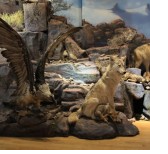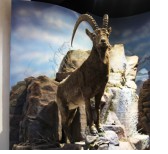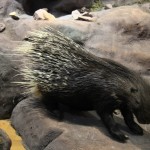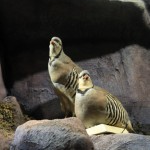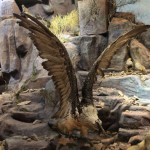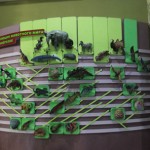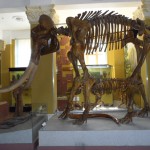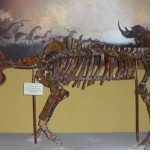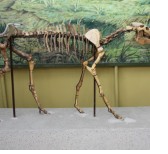
The history of animal evolution is revealed through the work of
palaeontologists; by decoding the fossil chronicles in the Earth’s rocks, scientists
have been able to recreate the landscapes of the Phanerozoic epoch (from 570 million
years ago to the present) contributing to our understanding of the history of
the modern fl ora and fauna of the Northern Hemisphere, including Kazakhstan.
Since the discovery of the skeleton of a giant rhinoceros in 1912, many further scientifi c discoveries have been made bringing international recognition to Kazakhstan as a unique country for paleontological research. The establishment of a natural history museum was fi rst proposed to house the numerous remains of ancient prehistoric animals collected by palaeontologists and geologists in the Turgay and Zaisan depressions of central Kazakhstan between 1948 and 1957. The idea was supported by the first president of the Academy of Sciences of the Kazakh SSR, academician Kanysh Satpayev and in 1959 the museum opened its doors to its first visitors. It soon gained wide popularity among citizens of Kazakhstan and foreign visitors. The main purpose of the museum is to promote knowledge of the fauna of Kazakhstan from the simplest to the most complex organisms and from the earliest geological epochs to the present day.
The palaeontology section of the museum features some very interesting exhibits with fossilized skeletons of animals and petrified wood, dating back to early geological epochs that were found in Kazakhstan. The collection includes fossilized skeletons of dinosaurs, giant rhinoceroses, mastodons, mammoths, elephants, ancient giant pigs, tortoises, and other animals that will leave the visitor feeling as if they have wandered into Jurassic Park.
The skeleton of a giant rhinoceros that was found on the Turgay steppe 100 years ago was one of the first exhibits in the museum. Indricotheriinae is a subfamily of Hyracodontidae, a group of long-limbed hornless rhinoceroses that evolved in the Eocene epoch and continued through to the early Miocene. The earlier Hyracodontidae species were modest-sized, fastrunning, and lightly built animals with little similarity to modern rhinos; however, the Indricotheriinae evolved and grew to huge sizes, reaching the peak of their evolution from the middle Oligocene through to the early Miocene period, when they had become truly gigantic animals.
The Indricotheriinae skeleton on display in the museum indicates that the giant animal was about 8 meters long and 5 meters in height. In the late 1950s and early 1960s, parts of skeletons of other giant rhinoceros were found and added to the collection. In the 1980s, the skeleton of another species of giant rhinoceros - Paraceratherium - was found which was even larger. This skeleton is also exhibited in rhinoceros that was found on the Turgay steppe 100 years ago was one of the first exhibits in the museum. Indricotheriinae is a subfamily of Hyracodontidae, a group of long-limbed hornless rhinoceroses that evolved in the Eocene epoch and continued through to the early Miocene. The earlier Hyracodontidae species were modest-sized, fastrunning, and lightly built animals with little similarity to modern rhinos; however, the Indricotheriinae evolved and grew to huge sizes, reaching the peak of their evolution from the middle Oligocene through to the early Miocene period, when they had become truly gigantic animals.
The Indricotheriinae skeleton on display in the museum indicates that the giant animal was about 8 meters long and 5 meters in height. In the late1950s and early 1960s, parts of skeletons of other giant rhinoceros were found and added to the collection. In the 1980s, the skeleton of another species of giant rhinoceros -Paraceratherium - was found which was even larger. This skeleton is also exhibited in the museum.
Part of the skeleton of a mastodon of the Zygolophodon species, which lived between 23.5 million and 5.3 million years ago, was found in Petropavlovsk region. The length of the femur of this unique fi nd is 1.5 metres.
Parts of the skeleton and the footprints of a species of Brontotheriidae found in Eocene sediments (between about 53 million and 33 million years ago) in Aktau, in the foothills of the Jungar Alatau mountain range, comprise one of the palaeontological discoveries of the century. Peculiarities in the structure of the anatomy and morphology of the skull, jaw, limbs, and other parts of the skeleton lead scientists to name this animal the “Aktautitan hippopotamopus,” a new genus and species of horned brontothere.
The display on zoology includes a great variety of birds, mammals, insects, amphibians, and reptiles inhabiting Kazakhstan. Through the landscape dioramas, visitors can discover the wonders of a mountain lake, or view the life of the Central Asian steppe with its herds of saiga and groves of tugai. The museum is a delightful place for exploring the natural beauty of Kazakhstan.
The museum staff organizes training sessions for professionals and special courses for students on historical geology and ancient animals, on helminthology and parasitology, and on environmental issues. A natural science educational centre for school pupils and students is currently being established. The staff also organizes regular educational guided tours and mobile exhibitions.
Unlike other natural history museums, which display exhibits collected from around the world, our museum exclusively displays the biodiversity of Kazakhstan’s fauna. The unique collection of the museum is an integral part of the national heritage of the Republic and is of great importance in enhancing the intellectual and cultural potential of society.

